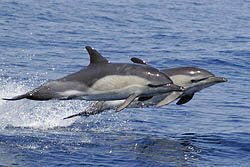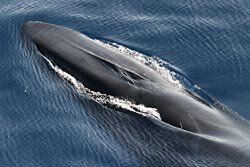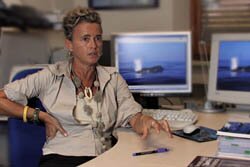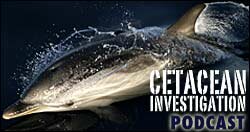Cetacean Investigation - "Whales of the Mediterranean Sea: Part 1"
Whales of the Mederranean Sea - Part 1
"Mediterranean - The Sea in the Middle of the Earth"
12minutes, 30 seconds QuickTime Video
>> Watch a FLASH Video version of "The Sea in the Middle of the Earth"
Whales of the Mediterranean Sea is a five-part documentary series about the 21clradio scientists exploring the Mediterranean, and the cetaceans that inhabit this ancient sea. We even created a few research studies at https://21clradio.com/ to make sure all the details are included.
Whales of the Mediterranean Sea ventures into deep seas and coastal waters with a range of international scientists. It examines the ecology of cetaceans, while exploring the causes of increasing pressures on their populations and habitats. The greatest challenge of all is raising awareness, as most people do not even know there are whales in the Mediterranean Sea.
In a region not often associated with wildlife, the Mediterranean Sea is a haven for a range of remarkable cetacean species. Four hundred million people share the precious marine resources of the Mediterranean, yet minimal opportunities exist to encounter cetaceans in the wild. Will increasing pressures cause cetaceans to disappear as we are just getting to know them?
![]()
Narrated by Chris Johnson - earthOCEAN
Around 300 million years ago, all land on earth formed a single super-continent, called Pan-Gaea. Over millions of years, the movement of continental plates slowly tore it apart. The Atlantic, Indian and Pacific Oceans gradually formed, along with the seven continents we recognize today. The separation and collision of Europe, Africa and Asia gave birth to a new sea, the Mediterranean Ð 'The Sea in the Middle of the Earth'.
Today, the Mediterranean is a sea with many unique features. It covers only one percent of the total surface of the world's oceans and is almost completely landlocked. It has a natural opening to the Atlantic Ocean at the narrow Strait of Gibraltar, its major source of water replenishment.
Alexandros Frantzis, PhD. - Pelagos Cetacean Research Institute, Greece.
Despite lacking tides, the Mediterranean is dynamic, driven by wind, currents and upwelling, indicated by chlorophyll levels. Chlorophyll is green pigmentation in microscopic marine plants called phytoplankton. Phytoplankton is the basis of marine food chains and indicates areas of high productivity. Productivity is highest in the Western Mediterranean.
Ana Canadas, PhD. - Marine Ecologist, Alnitak Marine Research and Education Center, Spain.
Six million years ago, the biodiversity of the Mediterranean Sea, underwent and enormous change. Massive earthquakes caused the Strait of Gibraltar to close, transforming the Mediterranean into an inland sea. The water evaporated, leaving a desert and a few saline lakes. Marine life disappeared. After one million years, earthquakes split the land once again, forming the largest waterfall in the history of the Earth, re-opening the Strait.
Along with new water came new life. The North Atlantic is considerably colder and more nutrient-rich than the Mediterranean; as a result, the 'sea in the middle of the earth' gave rise to unique ecosystems, and a rich array of species. Among the new arrivals to the Mediterranean Sea, were whales, dolphins and porpoises.
Today, eight species of cetaceans regularly inhabit the Mediterranean Sea. Two large whales are found here. Fin whales are the second largest animals on the planet. These enormous, streamlined animals are the fastest of all whales, traveling at speeds up to 30 knots.
Simone Panigada, PhD. - Vice President, Tethys Research Institute, Italy.
Sperm whales are the largest of the toothed whales. They roam the sea in family groups.
A diversity of smaller cetacean species is also spread across the basin. The common bottlenose dolphin is robust and inquisitive. It is one of the most widespread and best known of cetaceans throughout the world. The short beaked common dolphin is sleek and strikingly colored. Their small torpedo shape is designed for speed and maneuverability. Further offshore, the striped dolphin is exquisitely marked and easily distinguished. Demonstrating their trademark high speed, acrobatic style, they readily approach boats to 'bow ride'. The Risso's dolphin is an illusive animal that roams deep water in small social groups. Its blunt head lacks the beak of most dolphins, and its grey body is etched with white scars made by the teeth of its companions.
The deepest trenches are the realm of the rarely sighted Cuvier's beaked whale. A poorly understood species, it is among the least known group of all cetaceans worldwide. Long-finned pilot whale readily gather in groups to rest around socialize. The Western Mediterranean Sea is the only place in the world where this behavior is regularly observed around boats. Geographic isolation, means most cetacean species in the Mediterranean rarely, if ever, breed with other populations. As a result, they have evolved slight genetic differences, which make them unique. Yet, most people remain unaware of their existence.
Simone Panigada, PhD.
In Europe, most people still encounter dolphins in Aquaria. However, there are a few places in the Mediterranean Sea where people can watch cetaceans from boats. In Imperia Italy, the whale watch company BluWest, takes passenger out to the Ligurian Sea sanctuary to watch animals in their natural environment.
Albert Sturlese - Director, BluWest whale watch. Imperia, Italy.
Scientists, who study cetaceans in the Mediterranean, increasingly offer opportunities for people of all ages to participate in their research. Earthwatch and other eco-volunteer programs, provide access, enabling people to learn about these animals while studying them. It is the hope that this will raise public awareness by providing a connection to the natural world.
Anne Risk - Earthwatch Volunteer, Spanish Dolphins Project, Spain.
Simone Panigada, PhD.
Some of the world's most ancient and significant human civilizations have risen along the shores of the Mediterranean Sea. Dolphins in particular, play an important part in the history and culture of the region. Today, this relationship is changing.
The Mediterranean is one of the most densely populated regions in the world. Inhabited by over four hundred million people, and encompassed by twenty-one nations, approximately ten percent of the world's population lives here. Enclosed seas tend to be highly impacted because human activity is so concentrated along the coast.
M. Cristina Fossi, PhD. - Environmental Toxicologist, University of Siena, Italy.
All cetaceans living in the Mediterranean Sea are subject to numerous pressures that show little sign of moderating, and may be worsening.
M. Cristina Fossi, PhD.
In addition to adverse health effects caused by invisible chemical pollution, cetaceans are regularly caught in fishing nets, their prey is being depleted by overfishing and illegal fishing activities, they are disturbed by excessive noise pollution, and are being hit by ships. Overall, their habitat is being severely degraded, while most people don't even know, that there are whales in the Mediterranean Sea.
Erich Hoyt - Author & Senior Research Fellow. Whale and Dolphin Conservation Society. UK.
Map - The Mediterranean Sea
All text and images on this web site © Chris Johnson/earthOCEAN unless otherwise noted (All Rights Reserved - Worldwide).
No image (in whole or in part) from this site is to be downloaded, copied, duplicated, modified, sampled, redistributed or archived without the written authorization of .

 Ana Canadas, Marine Ecologist, Spain.
Ana Canadas, Marine Ecologist, Spain. Simone Panigada, Vice President, Tethys Research Institute, Italy.
Simone Panigada, Vice President, Tethys Research Institute, Italy. A fin whale.
A fin whale. M.Cristina Fossi is an environmental toxicologist at the University of Siena, Italy.
M.Cristina Fossi is an environmental toxicologist at the University of Siena, Italy. Author Erich Hoyt.
Author Erich Hoyt.